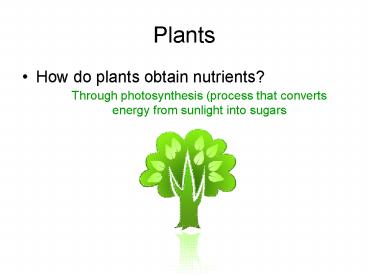Plants - PowerPoint PPT Presentation
1 / 28
Title:
Plants
Description:
Plants How do plants obtain nutrients? Through photosynthesis (process that converts energy from sunlight into sugars Plants are autotrophs which means they make ... – PowerPoint PPT presentation
Number of Views:308
Avg rating:3.0/5.0
Title: Plants
1
Plants
- How do plants obtain nutrients?
Through photosynthesis (process that converts
energy from sunlight into sugars
2
- Plants are autotrophs which means they make their
own food by photosynthesis. - During photosynthesis, plants use carbon dioxide
gas and water to make food and oxygen.
http//grapevine.net.au/grunwald/une/KLAs/science
/irrigation-photosynthesis.gif
3
6CO2 6H2O C6H12O6 6O2
- How do you read this equation in words?
- What are the reactants?
- What are the products?
Six carbon dioxide molecules plus 6 water
molecules yields 1 molecule of glucose and 6
water molecules
6CO2 and 6H2O (carbon dioxide and water)
C6H12O6 and 6O2 (glucose and oxygen)
4
Plant Cells and Photosynthesis
- In what organelle does photosynthesis occur?
- What are other organelles that plants have that
are not found in animal cells?
Chloroplast
5
- The cell wall is a boundary that surrounds the
cell membrane and separates the cell from its
environment. - The cell wall is made mostly of cellulose
- Chloroplasts are the structures where
photosynthesis takes place.
6
- A vacuole is a large storage area that contains
water, wastes and food. - The vacuole expands when water enters and shrinks
when water leaves.
http//www.biology4kids.com/files/art/cell_vacuole
1.jpg
7
Plant Structures
- Plants need adaptations to reduce water loss to
the air. - One adaptation is a waxy, waterproof layer called
the cuticle that covers the leaves of most plants - Tiny openings or pores found mostly on the
underside of a plant leaf used for gas exchange
are called stomata.
Stomata
8
- Epidermis is the single cell layer covering a
plant (especially the leaf). - Veins are used to transport food and water
throughout the leaf.
9
Plant Life Cycles
- Plants have complex life cycles that are made up
of 2 different stages or generations. - In one stage, called sporophyte, the plant
produces spores (tiny cells that can grow into
new organisms) - A spore develops into the next stage called a
gametophyte. - In this stage, the plant produces gametes (egg
and sperm cells) - The egg and sperm cell join to form a zygote.
10
Which components of this plant life cycle are
sexual? Asexual?
11
Mosses
- Nonvascular Plants are low growing plants that
lack vascular tissue. - Other nonvacular plants are liverworts and
hornworts.
Liverwort
Moss
Hornwort
12
Moss Life Cycle
13
Ferns
- Vascular plants are those that have vascular
tissue which transports water throughout the
plant.
Spores on underside of fern leaf.
14
Fern Life Cycle
15
Compare the moss and fern life cycles.
Moss Life Cycle
Fern Life Cycle
16
Gymnosperms
- Gymnosperms are plants that produce naked
seeds. - Seeds are not enclosed in a protective covering.
- Many gymnosperms also have needle-like or
scale-like leaves and deep growing root systems.
17
Gymnosperm Reproduction
- Most gymnosperms have reproductive structures
called cones. - Many plants produce both male and female cones
- Male cones produce tiny grains of pollen.
- Pollen contains the microscopic cells that will
later become sperm cells. - Female cones contain one ovule at the base.
- The ovule is the structure that contains an egg
cell.
18
Life Cycle of Gymnosperms
- Pollen falls from male cone onto a female cone.
- In time, a sperm cell and egg cell join together
in an ovule on the female cone. - After fertilization occurs, the zygote develops
into the embryo part of the seed.
19
Angiosperms
- Angiosperms are plants that produce seeds
enclosed in a fruit. - 2 characteristics of angiosperms
- Produce flowers
- Produce fruits
- The seeds develop in the ovary and the ovary is
located in the flower.
20
Structure of Flowers
- All flowers are used for reproduction.
- Petals- the colorful structures you see when the
flower opens. - When the flower is still a bud, it is enclosed by
leaf-like structures called sepals.
21
- Within the petals are the flowers male and
female reproductive parts. - Thin stalks topped by small knobs are called
stamens (male reproductive parts) - Pistils (female reproductive parts) are usually
found in the center of the flower.
22
Reproduction of Angiosperms
- Pollen falls on stigma.
- In time, sperm cell and egg cell join together in
the flowers ovule. - The zygote develops into the embryo part of the
seed.
23
Some key terminology
- Pollination transfer of pollen from male
reproductive structures to female reproductive
structures. - Fertilization joining of egg and sperm cells.
- Germination the early growth stage of the
embryo plant in a seed.
24
Where do you see pollination, fertilization and
germination?
25
Think back
- What is the difference between sexual and asexual
reproduction?
Sexual reproduction involves the joining of egg
and sperm cells Asexual reproduction involves
only one parent no joining of egg and sperm cells
26
Asexual Sexual Reproduction in Plants
- Asexual growing new plants by using cuttings
- Sexual pollination
- What are some common types of pollination?
27
Seeds
- Seeds are the result of sexual reproduction.
- Seeds are structures that contain a young plant
inside of a protective covering.
28
Spores
- Spores are tiny cells that are capable of growing
into a new organism. - Ferns release spores into their surroundings
where they grow into gametophytes.
http//upload.wikimedia.org/wikipedia/commons/8/8a
/Fern_spores_P1180804.jpg































